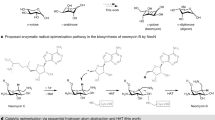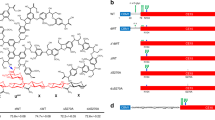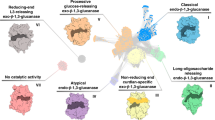Abstract
IN a recently published paper1, it was shown that a number of aldose sugars are oxidized at characteristic rates by the action of hypoiodous acid. The rate of oxidation appears to be related to the structural configuration for any particular aldose; thus glucose and xylose show a similar rate of oxidation, which is, however, different from that shown by galactose and arabinose, and different again from that shown by mannose. The magnitude of these variations in the rate of oxidation is sufficiently great to enable a positive identification of the configurational group to which any one of these aldoses may belong. This work (loc. cit.) suggested that kinetic measurements of the hypoiodous acid oxidation of sugar derivatives of the aldose type might yield valuable information on the structure of such derivatives.
This is a preview of subscription content, access via your institution
Access options
Subscribe to this journal
Receive 51 print issues and online access
$199.00 per year
only $3.90 per issue
Buy this article
- Purchase on Springer Link
- Instant access to full article PDF
Prices may be subject to local taxes which are calculated during checkout
Similar content being viewed by others
References
Ingles and Israel, J. Chem. Soc., 810 (1948).
Annual Reports, 78 (1922). Micheel and Micheel, Ber., 65, 253. Haworth, Lake and Peat, J. Chem. Soc., 271 (1939).
loc. cit. See also Myrbäck, Svensk. Kem. Tidsk., 51, 7, 74, 149, 179, 206, 225 (1939); 52, 21, 200, 293 (1940).
Author information
Authors and Affiliations
Rights and permissions
About this article
Cite this article
INGLES, O. Structure of Chitosamine. Nature 163, 484–485 (1949). https://doi.org/10.1038/163484a0
Issue Date:
DOI: https://doi.org/10.1038/163484a0
Comments
By submitting a comment you agree to abide by our Terms and Community Guidelines. If you find something abusive or that does not comply with our terms or guidelines please flag it as inappropriate.



